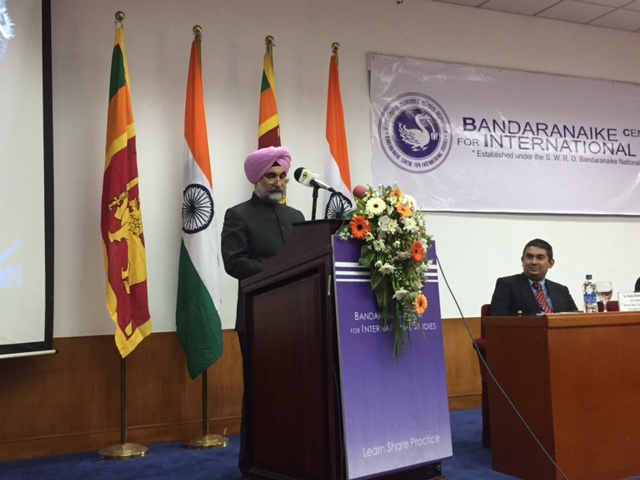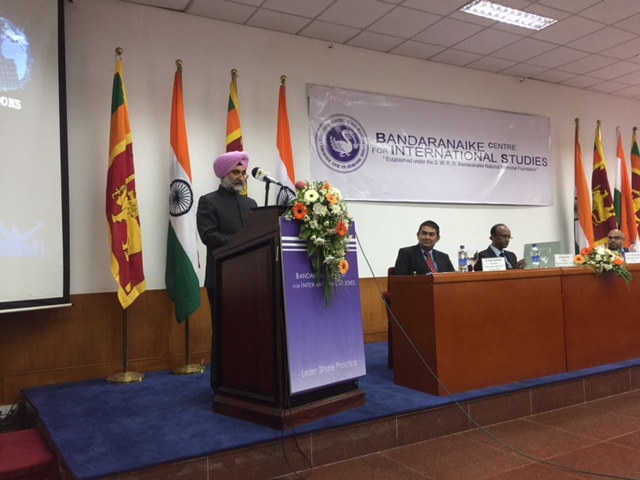- Home
- About Us
- Consular Services
- India-Sri Lanka Relations
- Media
- Country File
- Trade
- Education/ Scholarship
- Cultural SVCC
- Important links
- NDCA
Speeches & Statements
High Commissioner's speech at the Bandaranaike Centre for International Studies (BCIS), Colombo : India’s Global Outlook Speech at BCIS: India’s Global Outlook
March 25, 2017
Dr. Harinda Vidanage,
Prof. Mohan De Silva
Dr. Senaka Dharamatilleke and
Members of BCIS Faculty and Students
It is a privilege for me to be here today at the Bandaranaike Centre for International Studies. BCIS has been making invaluable contribution to enriching the field of International Relations over more than four decades.
It is the start of another Academic Year. It brings with itnew friends,new hopes and sometimes new challenges. It takes me back to my own University days, where, just like you, I also studied International Relations. Later I became a diplomat. You and I share a unique bond.
Relationship between countries just like between individuals, are complex, and not easy to understand, analyse, let alone, predict. This is what makes it, interesting and exciting. However,despite the several layers of complexities, which one sees on the surface, human beings the world over, essentially have the same set of dreams and aspirations. “YatraViswam Bhavathyeka Needam", the whole world is a nest, as they say in the Vedas.
In today’s world, we continue to see rapid strides in Science and Technology. This has brought about, a sea change,in the way we live. Also, there is a renewed focus, worldwide on ‘good governance’. In other words, yahapalanayahas gone global! Governments have taken performance, and delivery seriously, and are genuinely, making an attempt, to make a difference, to the lives of average citizens.
We see the historical past, being buried to build a promising future. 2015 was witness to the restoration of diplomatic relations, between the US and Cuba, after a gap of 54 years. Columbia struck a peace deal, with FARC in 2016, to bring an endto more than 50 years of conflict. These developments, underline the need for, out of box thinking; the importance of moving ahead, without being hostage, to the past.
On the other hand, we also see a pause, in the globalisation process. We see the winds of protectionism, blowing across continents. The world seems to suddenly look inwards, rather than outwards. Over the last several decades, the world has enjoyed the benefits, from fruitful exchange of products, services and ideas; there has been, a significant increase, in specialization and productivity; in overall standard of living, of the common man, and in cross-cultural awareness. We need to recognize it.
While some things, have changed substantially, others have not changed, at all. Terrorism continues unabated. From world capitals, to rural hinterlands, its reach has spread. Some states continue,to sponsor terror, with impunity. United Nations remains a forum, which is not reflective of today’s global order. Multilateralism stillrefuses to acknowledge, the multi-polarity of today’s world. The democratization of global order,remains elusive.
Given this backdrop, what is India’s global outlook? Over the years,Indian domestic situation,hasseen a sea-change. India's trade to GDP ratio, has risen dramatically, since the reforms began in 1990s. So has capital flows, relative to GDP. Indian economy today, is far more open, and integrated, into the world economy, than most people realise. This has brought rich dividends. India grew fastest, among major economies worldwide, at over 7.5 per cent in 2016. India will continue to drive, global growth in 2017, and its share in the world GDP, is expected to rise to 17%. We have a shared interest, in seeing an open world.
Brand India is here to stay. By 2020, the average age in India will be 29, and it is set to become the world’s youngest country, with 64% of its population, in the working age group. With Western Europe, the US, South Korea, Japan and even China aging, this demographic potential, offers India, an unprecedented edge, which could further contribute, to GDP growth rate.
It is a different India, that one sees today. In 2016, India overtook the US in terms of internet users. At 227 million people, India’s internet user base, is now the second largest in the world. With India becoming, one of iPhone's fastest growing markets, Apple has decided to assemble, the iPhone in Bengaluru, making India the 3rd country, to do the final assembly of iPhones. The world’s largest solar power plant ![]() , was recently unveiled, in Tamil Nadu. India is running, the largest renewable energy expansion programme, in the world. For the first time in space history, Indian Space Research Organization (ISRO) launched a record 104 satellites, in one go, in February 2017, out of which 100 satellites, belong to foreign nations.
, was recently unveiled, in Tamil Nadu. India is running, the largest renewable energy expansion programme, in the world. For the first time in space history, Indian Space Research Organization (ISRO) launched a record 104 satellites, in one go, in February 2017, out of which 100 satellites, belong to foreign nations.
It has been a chrysalis-liketransformation for India,from a young independent nation, with little economic resources,to thefastest growing major economy, in the world. The world has realized, and recognized, India’s leadership role. As the largest democracy in the world,andperhaps the world’s most intricate, and pluralistic society, India’s journey has been watched, with keenness by the world, at large.One thing which has remained with usthroughout, is our belief, in the basic tenet,of our foreign policy: strategic autonomy.
So, what is the aim of India’s foreign policy? The core aim of India’s foreign policy,is to meet the developmental aspirations of its 1.25 billion people. Our Diplomacy, is for our Development. D for D! India also, looks at engaging effectively, with the world, to meet common challenges.
In recent times, our foreign policy has become more proactive, focussed and action-oriented, thanks to the vision of our leadership. We have made huge efforts, in reengaging our Diaspora. We have taken steps, to make new friends, as well as strengthen, the breadth and depth of friendship with existing partners.
The world appreciated India’s leadership, in the finalization of the Paris COP-21 Agreement. International Solar Alliance, UN International Day of Yoga are other examples, where we demonstrated our willingness to shoulder global responsibilities.The mammoth evacuation/rescue operations in Yemen, Libya, Iraq, Ukraine, Nepal etc. which India undertook,validated our genuine willingness, to help not only our citizens, but all others, who came to us for assistance, irrespective of the colour of the passport.
We have cemented our relations with our neighbours; and with our extended neighbours. We have reenergised our partnership with P-5. Our ties with the US have been transformational; having served in the US till recently, I have seen it happen just before my eyes. Our relations with China have expanded, in areas where, we have commonality of views. In recent times, India-Japan ‘Special Strategic and Global Partnership’ has further strengthened. We hosted the largest ever, India-Africa Summit. We have reconnected, with Latin America. For the first time, we hosted the Forum of India-Pacific Island Cooperation. We have made steady progress, in our ties with the West. While we have ‘acted East, we have also linked West.’The first ever India-Arab League Ministerial Conference, held in Manama, outlined our expanding outreach with the Arab World. Our relations with Saudi Arabia, UAE and other West Asian countries have gained unprecedented depth.
I want to elaborate on the neighbourhood. Our Neighbourhood First policy, is the reflection of the importance, we attach to our nearest partners. We see our future, as intertwined. The scale and speed, of economic transformation in India, is an opportunity, that we do not want our friends, especially our neighbours, to miss. India’s growth, is not, in the interest of India alone. We want you, to be part, of our growth story.
India sees itself as a net provider of security, in the Indian Ocean Region. We also see ourselves, as the First Responder in HA/DR operations in the Region (Humanitarian Assistance/Disaster Relief). The first Indian naval helicopters, reached Sri Lanka, with immediate relief material, within 12 hours of Tsunami tragedy in 2004. Similarly, we responded swiftly with assistance, when the landslides, hit Sri Lanka last year. We are again extending a helping hand to Sri Lanka for drought relief.
I see a huge window of opportunity, for India-Sri Lanka ties. We will soon be launching a SAARC communications and meteorology satellite; which also has Sri Lankan partnership.There is a lot, that we can do together. We are keen to integrate, Sri Lankan economy, in the global supply and value chain. We are ready, to share our skill set, with Sri Lanka. We are interested, in making investments in energy; hard infrastructure and connectivity projects. We have a robust development partnership. We are ready to sail with Sri Lanka in its journey towards a more secure, prosperous and fulfilling future. All we need to do, is to think and act, and act now. As Gautama Buddha once said, “We are what we think. All that we are, arises with our thoughts. With our thoughts, we make the world.”
Thank you…I wish you all a bright future!


* * * * *









